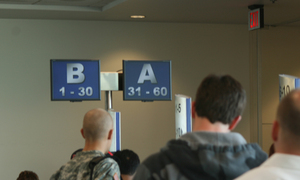Updated 10/1/09
Over the past 18 months, Southwest Airlines has significantly changed its boarding process. No longer do people camp out to get onboard a flight an hour or more ahead of time. Instead, they can line up just as their boarding group is called. All they have to do is be able to distinguish between the letters A, B and C and the numbers 1 through 60 (Figure 1). For the most part, folks can do this, although I have seen a few try to ignore this organizational process.
The problem is that what is no longer evident at the boarding area is now taking place online. In fact, recently, I found myself caught up in the check-in frenzy.
You see, everyone wants to board the plane first for several reasons. First, they get a seat up front and can thus get off the plane quicker. Others want to avoid that dreaded middle seat. Still others want an aisle seat for easier restroom access. I, on the other hand, want a window seat so I can cloud watch.
Whatever the reason, it has become apparent that to get a good seat, one has to be on the A-List [(see this link if you are logged in as a Rapid Rewards – Southwest Frequent Flyer – member (https://www.southwest.com/rapid_rewards/aList_membership_rules.html)], pay extra for Earlybird Check-In, an option added during the summer of 2009, or get a seating assignment exactly (and I mean EXACTLY) 24 hours prior to flight departure time.
For the former, the Southwest web site notes, “A Rapid Rewards Member who flies 32 qualifying one-way revenue flights in a 12-month period becomes eligible for Rapid Rewards’ A-List membership…entitled to reserved boarding privileges for 12 months…automatically reserve a boarding pass for the Member 36 hours prior to each of the Member’s confirmed Southwest Airlines’ flights to ensure the Member will receive the best available boarding pass…”
Now, if only I could arrange for 16 roundtrips or 32 one-way trips in a twelve month period. For most of us mere mortals, that is a difficult (more likely impossible) task.
And, while paying only ten dollars extra per one-way trip doesn’t seem like a lot, it’s twenty dollars round-trip and a hundred dollars after just five trips.
The alternative is to be poised in front of one’s computer at exactly 24 hours and 15 seconds prior to scheduled flight departure time, ready to hit the “retrieve reservation” button.
After getting C boarding status about a month ago, I knew I had to do this, especially when flying with my wife.
So, with two screens open (because of how we purchased our tickets), I hit the enter keys at exactly 24 hours and 23 hours, 59 minutes and 58 seconds, respectively, to obtain our two boarding passes. Once the reservations appeared, I immediately “checked in.”
I received seating assignment A25, but my wife landed A41 (Figure 2).
Thus, there was little doubt that other Southwest ticket holders had discovered the same or similar check-in techniques.
Sitting onboard our flight to Baltimore, we somehow managed to chat with our seatmate, a businessman from the northeast. He added a more interesting spin to the check-in scenario.
It seems that when he and his coworkers travel enmasse, they all follow the above check-in process and even bet on who will get to board the plane first. Imagine, if you will, that 7 adults from the same business are all at that computers, hitting their enter buttons simultaneously, and then comparing seating assignments. Sounds a bit like a lottery to me!
So, now we are ready to return home. Alas, my wife and I won’t be at the National Council of Teachers of Mathematics Convention at the magical check-in time. So, upon arriving at the conference, I immediately went to the Cyber Café, logged in, and with two windows open checked us in together. Wonder of wonders, we got adjacent boarding numbers – B3 and B4 (Figure 3). I was thrilled that even with late check-in, we’d have our pick of seats.
When we arrived at the airport, I discovered another wrinkle in my strategy. For originating flights, your boarding number is a good gauge of opportunity. For connecting flights, there’s yet another lottery – how many people remain on the flight. In our case, there were 49 people already onboard, plus 62 before us. It was almost as though we were in the C boarding group again.
The only aspect of our travel yet to be addressed is “boarding assignment separation.” Assuming that we are separated, I’ve discovered that the gate operations agent may or may not let us board together. Apparently, that’s their option. So, should this ever occur, I’ll likely be placing my computer case on her “reserved” seat, suggesting to my fellow travelers that she’s in the necessary room. It worked on the flight to Baltimore!
Regardless of the wrinkles, the new boarding procedure is far superior to the old. Perhaps even more important is that Southwest has demonstrated that it listens to its customers. I guess that is one of the many reasons that this so-called upstart, low-cost airline is, in my humble opinion, THE premier airline. In fact, I LUV it!
So, as I get ready for my next flight, I can hear the countdown reminiscent of the Fox TV Show “24” in the background:
24 hours…15 seconds
24 hours…14 seconds
24 hours…13 seconds
Reference:
- www.associatedcontent.com/article/45265/southwest_airlines_and_assigned_seating.html?
- www.associatedcontent.com/article/389526/the_ins_and_outs_of_travel_on_southwest_pg2.
- www.southwest.com/flight/early-bird-retrieve-reservation.html?int=HOMETVLP0100EBRD090
